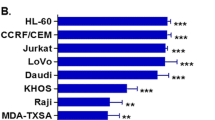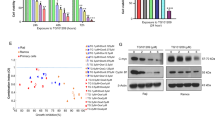Abstract
Tumor necrosis factor (TNF) is a pleiotropic cytokine that potentiates the cytotoxic effects of chemotherapeutic drugs. Although emergence of resistance to chemotherapeutic drugs is a major problem in cancer therapy, its mechanism is incompletely understood. Recently, activation of a nuclear transcription factor NF-κB has been reported to be a signal for anti-apoptosis. In this report, we investigated the effect of TNF on activation of NF-κB, c-Jun N-terminal kinase (JNK), and apoptosis in vincristine-resistant human histiocytic lymphoma U937-VR cells. Unlike the parent clone (U937-VS), no activation of caspase-3, known to be required for apoptosis, was found in vincristine-resistant cells on exposure to vincristine. These cells were also more resistant than U-937-VS cells to doxorubicin, daunomycin, and taxol. TNF-induced NF-κB activation, IκB α degradation, and nuclear translocation of p65 were all found to be highly suppressed in the U-937-VR cells. NF-κB activation by LPS, H 2 O 2 , and okadaic acid was also suppressed. However, vincristine resistance enhanced TNF-induced JNK activation. When examined for apoptosis, vincristine resistance suppressed the cytotoxic effects and caspase-3 activation by TNF. The resistant phenotype in U937-VR cells was independent of the expression of the apoptosis-suppressor, Bcl-2. Thus, overall these results indicate that vincristine resistance correlates with suppression of NF-κB activation, cytotoxicity, and caspase-3 activation but enhancement of JNK activation by TNF.
Similar content being viewed by others
References
Bellamy WT. P-glycoproteins and multidrug resistance. Ann Rev Pharmacol & Toxicol 1996; 36: 161-183.
Broxterman HJ, Giaccone G, Lankelma J. Multidrug resistance proteins and other drug transport-related resistance to natural product agents. Current Opin Oncol 1995; 7: 532-540.
Reed JC. Regulation of apoptosis by bcl-2 family proteins and its role in cancer and chemoresistance. Current Opin Oncol 1995; 7: 541-546.
Harrison DJ. Molecular mechanisms of drug resistance in tumors. J Pathol 1995; 175: 7-12.
Lowe SW. Cancer therapy and p53. Current Opin Oncol 1995; 7: 547-553.
Scheffer GL, Wijngaard PL, Flens MJ, Izquierdo MA, Slovak ML, Pinedo HM, Meijer CJ, Clevers HC, Scheper RJ. The drug resistance-related protein LRP is the human major vault protein. Nature Med 1995; 1: 578-582.
Cummings J, Smyth JF. DNA topoisomerase I and II as targets for rational design of new anticancer drugs. Ann Oncol 1993; 4: 533-543.
Lowe SW, Ruley HE, Jacks T, Housman DE, et al. p53-Dependent apoptosis modulates the cytotoxicity of anticancer agents. Cell 1993; 74: 957-967.
Beg AA, Baltimore D. An essential role for NF-kappaB in preventing TNF-alpha-induced cell death. Science 1996; 274: 782-784.
Van Antwerp DJ, Martin SJ, Kafri T, Green DR, Verma IM. Suppression of TNF-alpha-induced apoptosis by NF-kappaB. Science 1996; 274: 787-789.
Wang CY, Mayo MW, Baldwin AS Jr. TNF-and cancer therapy-induced apoptosis: potentiation by inhibition of NF-kappaB. Science 1996; 274: 784-787.
Thanos D, Maniatis T. NF-kappaB: a lesson in family values. Cell 1995; 80: 529-532.
Verma IM, Stevenson JK, Schwarz EM, Van Antwerp D, Miyamoto S. Rel/NF-κ B/IkappaB family: intimate tales of association and dissociation. Genes & Dev 1995; 9: 2723-2735.
Baldwin AS Jr. The NF-kappaB and IkappaB proteins: new discoveries and insights. Annu Rev Immunol 1996; 14: 649-683.
Barnes PJ, Karin M. Nuclear factor-kappaB: a pivotal transcription factor in chronic inflammatory diseases. New Engl J Med 1997; 336: 1066-1071.
Baichwal VR, Baeuerle PA. Activate NF-kappaB or die? Current Biol 1997; 7: R94-96.
Baeuerle PA, Baltimore D. NF-kappaB: ten years after. Cell 1996; 87: 13-20.
Baeuerle PA, Henkel T. Function and activation of NF-kappaB in the immune system. Annu Rev Immunol 1994; 12: 141-179.
Scherer DC, Brockman JA, Chen Z, Maniatis T, Ballard DW. Signal-induced degradation of IkappaB alpha requires site-specific ubiquitination. Proc Natl Acad Sci USA 1995; 92: 11259-11263.
Lum BL, Gosland MP, Kaubisch S, Sikic BI. Molecular targets in oncology: implications of the multidrug resistance gene. Pharmacotherapy 1993; 13: 88-109.
Raderer M, Scheithauer W. Clinical trials of agents that reverse multidrug resistance. A literature review. Cancer 1993; 72: 3553-3563.
Kellen JA, Kellen JA. The reversal of multidrug resistance in cancer. Anticancer Research 1993; 13: 959-961.
Wadler S, Schwartz EL. Antineoplastic activity of the combination of interferon and cytotoxic agents against experimental and human malignancies: a review. Cancer Res 1990; 50: 3473-3486.
Lejeune F, Lienard D, Eggermont A, Schraffordt Koops H, Kroon B, Gerain J, Rosenkaimer F, Schmitz P. Clinical experience with high-dose tumor necrosis factor alpha in regional therapy of advanced melanoma. Circulatory Shock 1994; 43: 191-197.
Walther W, Stein U, Pfeil D. Gene transfer of human TNF alpha into glioblastoma cells permits modulation of mdr1 expression and potentiation of chemosensitivity. Intl J Cancer 1995; 61: 832-839.
Pantazis P, Chatterjee D, Han Z, Wyche J, DeJesus A, Giovanella B. Monocytic differentiation and synthesis of proteins associated with apoptosis in human leukemia U-937 cells acquiring resistance to vincristine. Eur J Haematol 1996; 57: 79-86.
Ibrado AM, Huang Y, Fang G, Liu L, Bhalla K. Overexpression of Bcl-2 or Bcl-xL inhibits Ara-C-induced CPP32/Yama protease activity and apoptosis of human acute myelogenous leukemia HL-60 cells. Cancer Res 1996; 56: 4743-4748.
Chaturvedi MM, La Pushin R, Aggarwal BB. Tumor necrosis factor and lymphotoxin. Qualitative and quantitative differences in the mediation of early and late cellular response. J Biol Chem 1994; 269: 14575-14583.
Bradford MM. A rapid and sensitive method for the quantitation of microgram quantities of protein utilizing the principle of protein-dye binding. Anal Biochem 1976; 72: 248.
Tewari M, Quan LT, O'Rourke K, Desnoyers S, Zeng Z, Beidler DR, Poirier GG, Salvesen GS, Dixit VM. Yama/CPP32 beta, a mammalian homolog of CED-3, is a CrmA inhibitable protease that cleaves. Cell 1995; 81: 801-809.
Schreiber E, Matthias P, Muller MM, Schaffer, W. Rapid detection of octamer binding proteins with mini-extracts, prepared from a small number of cells. Nucleic Acids Res 1989; 17: 6419.
Karin M. Signal transduction from the cell surface to the nucleus through the phosphorylation of transcription factors. Curr Opin Cell Biol 1994; 6: 415-424.
Tsujimoto Y, Croce CM. Analysis of the structure, transcripts, and protein products of bcl-2, the gene involved in human follicular lymphoma. Proc Natl Acad Sci USA 1986; 83: 5214-5218.
Reed JC, Tsujimoto Y, Alpers JD, Croce CM, Nowell PC. Regulation of bcl-2 proto-oncogene expression during normal human lymphocyte proliferation. Science 1987; 236: 1295-1299.
Simonian PL, Didier AM, Nunez G. Bcl-2 and Bcl-xL can differentially block chemotherapy-induced cell death. Blood 1997; 90: 1208-1216.
Korsmeyer SJ. Regulators of cell death. Trends in Genetics 1995; 11: 101-105.
Borsellino N, Crescimanno M, Flandina C, Flugy A, D'Alessandro N. Combined activity of interleukin-1 alpha or TNF-alpha and doxorubicin on multidrug resistant cell lines: evidence that TNF and DXR have synergistic antitumor and differentiation-inducing effects. Anticancer Res 1994; 14: 2643-2648.
Evans CH, Baker PD. Decreased P-glycoprotein expression in multidrug-sensitive and-resistant human myeloma cells induced by the cytokine leukoregulin. Cancer Res 1992; 52: 5893-5899.
Fogler WE, Pearson JW, Volker K, Ariyoshi K, Watabe H, Riggs CW, Wiltrout RH, Longo DL. Enhancement by recombinant human interferon alfa of the reversal of multidrug resistance by MRK-16 monoclonal antibody. J Natl Cancer Inst 1995; 87: 94-104.
Kikuchi A, Holan V, Minowada J. Effects of tumor necrosis factor alpha, interferon alpha and interferon gamma on non-lymphoid leukemia cell lines: growth inhibition, differentiation induction and drug sensitivity modulation. Cancer Immunol Immunother 1992; 35: 257-263.
Wang CY, Mayo MW, Baldwin AS Jr. TNF-and cancer therapy-induced apoptosis: potentiation by inhibition of NF-kappaB. Science 1996; 274: 784-787.
Van Antwerp DJ, Martin SJ, Kafri T, Green DR, Verma IM. Suppression of TNF-alpha-induced apoptosis by NF-kappaB. Science 1996; 274: 787-789.
Liu ZG, Hsu H, Goeddel DV, Karin M. Dissection of TNF receptor 1 effector functions: JNK activation is not linked to apoptosis while NF-kappaB activation prevents cell death. Cell 1996; 87: 565-576.
Duyao MP, Buckler AJ, Sonenshein GE. Interaction of an NF-kappaB-like factor with a site upstream of the c-myc promoter. Proc Natl Acad Sci USA 1990; 87: 4727-4731.
Casano FJ, Rolando AM, Mudgett JS, Molineaux SM. The structure and complete nucleotide sequence of the murine gene encoding interleukin-1 beta converting enzyme (ICE). Genomics 1994; 20: 474-481.
Cheng J, Liu C, Koopman WJ, Mountz JD. Characterization of human Fas gene. Exon/intron organization and promoter region. J. Immunol. 1995; 154: 1239-1245.
Fraser A, Evan G. A license to kill. Cell 1996; 85: 781-784.
Fisher DE. Apoptosis in cancer therapy: crossing the threshold. Cell 1994; 78: 539-542.
Kaufmann SH, Desnoyers S, Ottaviano Y, Davidson NE, Poirier GG. Specific proteolytic cleavage of poly(ADP-ribose) polymerase: an early marker of chemotherapy-induced apoptosis. Cancer Res 1993; 53: 3976-3985.
Datta R, Manome Y, Taneja N, Boise LH, Weichselbaum R, Thompson CB, Slapak CA, Kufe D. Overexpression of Bcl-xL by cytotoxic drug exposure confers resistance to ionizing radiation-induced internucleosomal DNA fragmentation. Cell Growth & Differentiation 1995; 6: 363-370.
Han Z, Chatterjee D, Early J, Pantazis P, Hendrickson EA, Wyche JH. Isolation and characterization of an apoptosis-resistant variant of human leukemia HL-60 cells that has switched expression from Bcl-2 to Bcl-xL. Cancer Research 1996; 56: 1621-1628.
Oltvai ZN, Milliman CL, Korsmeyer SJ. Bcl-2 heterodimerizes in vivo with a conserved homolog, Bax, that accelerates programmed cell death. Cell 1993; 74: 609-619.
Brach MA, Gruss HJ, Sott C, Herrmann F. The mitogenic response to tumor necrosis factor alpha requires c-Jun/AP-1. Mol Cell Biol 1993; 13: 4284-4290.
Derijard B, Hibi M, Wu IH, Barrett T, Su B, Deng T, Karin M, Davis RJ. JNK1: a protein kinase stimulated by UV light and Ha-Ras that binds and phosphorylates the c-Jun activation domain. Cell 1994; 76: 1025-1037.
Sanna MG, Duckett CS, Richter BWM, Thompson CB, Ulevitch RJ. Selective activation of JNK1 is necessary for anti-apoptotic activity of hILP. Proc Natl Acad Sci USA 1998; 95: 6015-6020.
Author information
Authors and Affiliations
Rights and permissions
About this article
Cite this article
Giri, D.K., Pantazis, P. & Aggarwal, B.B. Cellular resistance to vincristine suppresses NF-κB activation and apoptosis but enhances c-Jun-NH2-terminal protein kinase activation by tumor necrosis factor. Apoptosis 4, 291–301 (1999). https://doi.org/10.1023/A:1026413111733
Issue Date:
DOI: https://doi.org/10.1023/A:1026413111733




